An Ontological Model for the Representation of Vallenato as Cultural Heritage in a Context-Aware System
Abstract
1. Introduction
2. Related Work
3. Ontology Model
3.1. Selected Methodology
- Scenario 1. Development of ontology networks from specification to implementation;
- Scenario 2. Development of ontology networks through reuse and reengineering of non-ontology resources;
- Scenario 3. Development of ontology networks by reusing ontology resources;
- Scenario 4. Development of ontology networks through reuse and reengineering of ontology resources;
- Scenario 5. Development of ontology networks by reusing and mixing ontology resources;
- Scenario 6. Development of ontology networks through reuse, mixing and reengineering of ontology resources;
- Scenario 7. Development of ontology networks by reusing ontology design patterns;
- Scenario 8. Development of ontology networks by restructuring ontology resources;
- Scenario 9. Development of ontology networks by localization of ontology resources.
3.2. Specification of Requirements
- Task 1: Identification of the purpose, scope, and implementation language of the ontology:
- Purpose
- Scope
- The Ontology comprised the following concepts:
- ◦
- Artists (Composers, Musicians);
- ◦
- Cultural Event;
- ◦
- Cultural Managers (Managers, Historians, Researchers, Event organizers);
- ◦
- Cultural_Site;
- ◦
- Devices;
- ◦
- Environment;
- ◦
- Interface;
- ◦
- Learning Object;
- ◦
- Localization;
- ◦
- MOOC;
- ◦
- Persons (Instructors, Student, Tourist);
- ◦
- Preference;
- ◦
- Profile;
- ◦
- Red;
- ◦
- Time;
- ◦
- Vallenata Songs.
- Implementation language
- Task 2: Identification of the intended end users.
- Task 3: Identification of intended uses
- Store and edit information about users (Students, tourists, musicians, Instructors, other users);
- Store and edit information about the context of users;
- Store and edit information about MOOCs;
- Store and edit information about the devices that users can access;
- Store and edit users’ network information;
- Store and edit location information;
- Store and edit information about weather;
- Store and edit information about the users’ environment (Artists, Persons, Cultural Managers);
- Store and edit user interface information;
- Store and edit information about vallenato related cultural events;
- Store and edit information about user preferences, profiles, and user roles;
- Store and edit information about vallenato songs.
- Task 4: Identification of requirements.
- Non-functional requirements
- The ontology network must be Modular;
- The ontology network must be in English.
- Functional requirements
- Task 5: Grouping of the functional requirements
- Task 6: Validation of the set of requirements
- Task 7: Prioritization of the set of requirements
- The ontology network must be Modular;
- The ontology network must be in English.
- Task 8: Extraction of terminology and its frequency.
3.3. Graphic Design of the Ontology
- Vallenatas Songs: Describes the information of the vallenato compositions, such as lyrics, genre (merengue, paseo, puya, and son), duration;
- Artists: Describes the information of the composers and musicians related to vallenato, such as their personal information and relates the songs composed (composers) and performed (musicians);
- Devices: Describes the devices, both software and hardware, in context;
- Environment: Describes information about the environment of people, artists, and cultural managers;
- People: Describes the information of the people involved in the context, such as students (those enrolled in the MOOCs), instructors (those who teach using the platform, those who make use of the MOOCs), and tourists (describes the visitors from anywhere in the world who attend the vallenato events);
- Cultural Event: Describes the information of the events related to the vallenato, these events can be festivals, concerts, talks, private parties, among others;
- Cultural Managers: Describes the information of the people who promote Colombian vallenato from different fronts (event organizers, artists’ representatives, historians, and researchers);
- Interface: Describes the interface of the MOOCs and the learning objects inspired by the vallenato culture;
- Location: Describes the location of the context of all the elements that make up the model;
- MOOC: Describes the information of the massive open online courses to teach about vallenata culture that can be developed in the context;
- Learning Object: Describes the different learning objects based on vallenata culture used in the context;
- Profile: Describes the profile of the actors (people, artists, cultural managers) involved in the process;
- Preference: Describes the preferences of the actors (people, artists, cultural managers) involved in the process;
- Network: Describes the characteristics of the network connectivity of the devices owned by the actors (people, artists, cultural managers) involved in the process;
- Cultural sites: Describes the cultural sites related to vallenato;
- Time: Describes the notion of time in the context of vallenato.
4. Ontology in Protégé
5. Situations or Behavior for a Vallenato Management Environment Supported by Contextual Awareness
- A student of X age enrolls in a massive open, online course;
- Vallenata music artist A performs at a cultural event EC;
- Vallenata music composer C writes song V, which is performed at the CE event;
- The researcher designs a Massive Open Online Course inspired by the vallenata culture;
- Student A is enrolled in Massive Course 1 that was designed by a researcher, inspired by vallenata songs and contains a learning object 1;
- Student A receives a notification of enrollment in the Massive Open and Online Course;
- A Massive Open Online Course is inspired by one or more vallenato songs;
- The student has a learning object associated with his/her Massive Open Online Course;
- Instructor B designs a learning object inspired by a vallenata song composed by a composer C and performed by a musician M and inserts it in the Massive Open Online Course 1;
- Tourist 1 attends the cultural event 1 where a vallenata music composer C and a musician M perform;
- The system helps the tourist with the information of the vallenato musicians of his preference;
- The system helps the students to choose the mass course of their preference taking into account the vallenato songs they listen to;
- The system helps the tourist to locate the cultural event related to vallenato where the artists of his preference are performing;
- The Event Organizer organizes an event related to vallenato that can be a festival, conversation, parranda, concert, among others;
- The Manager represents the vallenato artists that are hired to perform at cultural events;
- Students connect through their device to the Massive Open Online Course they are enrolled in;
- Students solve the activities contained in the learning object of the Massive Open Online Course from their device;
- People research about vallenato from their devices by reading NFC tags, QR codes located in different places of the Cultural Museum of Vallenato Music;
- Composers show their unpublished songs from their devices;
- People located in a U location review the location of cultural events related to vallenato;
- Students connect via their device to the Massive Open Online Course they are enrolled in; the contents are adjusted to the network characteristics of the device.
6. Ontology Evaluation by Means of SWRL Rules
7. Comparison of the Proposed Ontology Model with Other Ontologies
- Explicit definition of the class in the context model (✓);
- Explicit definition of the class by means of subclasses in the context model (✓/);
- Partial definition of the class through a single class or subclass contained in the model (P);
- Partial definition of the class through different classes or subclasses contained in the model (P/);
- Class not explicitly or partially defined (X).
8. Conclusions
9. Future Works
Author Contributions
Funding
Data Availability Statement
Acknowledgments
Conflicts of Interest
References
- Corzo, F.C.; Araujo, J.C.Q.; Vernot, D.; Díaz, I.S. Identificación histórica, geográfica y cultural en la elaboración de dulces tradicionales de Valledupar: Un acercamiento para su conocimiento técnico. Perspect. Nutr. Humana 2017, 19, 209–223. [Google Scholar] [CrossRef]
- Baquero Montoya, Á.; De la Hoz Siegler, A. Cultura y tradición oral en el Caribe Colombiano. Mem. Rev. Digit. Hist. Arqueol. Desde Caribe Colomb. 2011, 8, 137–141. [Google Scholar]
- Ministerio de Cultura. Plan Especial de Salvaguardia Para la Música Vallenata Tradicional del Caribe Colombiano; Ministerio de Cultura: Valledupar, Colombia, 2013.
- Noguera, C.A. Vallenatología, Orígenes y Fundamentos de la Música Vallenata; Ediciones Tercer Mundo: Bogotá, Colombia, 1973. [Google Scholar]
- Unesco. El Vallenato, Música Tradicional de la Región del Magdalena Grande; Unesco: Windhoek, Namibia, 2015. [Google Scholar]
- Romero, R. Autores del Plan Especial de Salvaguardia del Vallenato Hablan del Reconocimiento que Recibió el Género por la Unesco. Available online: https://www.elheraldo.co/tendencias/ahora-el-vallenato-es-patrimonio-cultural-del-mundo-mincultura-231267 (accessed on 1 December 2015).
- Doerr, M. The CIDOC conceptual reference module: An ontological approach to semantic interoperability of metadata. AI Mag. 2003, 24, 200. [Google Scholar] [CrossRef]
- Ranjgar, B.; Niaraki, A.S.; Shakeri, M.; Choi, S. An ontological data model for points of interest (POI) in a cultural heritage site. Herit. Sci. 2022, 10, 22. [Google Scholar] [CrossRef]
- Ivanova, V.A.; Stoyanova-Doycheva, A.; Stoyanov, S.; Glushkova, T.; Doychev, E. Cyber-Physical-Social Systems and Applications: Part 1: Reference Architecture; LAP LAMBERT Academic Publishing: Saarland, Germany, 2019. [Google Scholar]
- Madanska, S. An Ontology for Architectural Heritage: Historical Figures and Organizations. In Proceedings of the Digital Presentation and Preservation of Cultural and Scientific Heritage, Burgas, Bulgaria, 23–25 September 2022. [Google Scholar] [CrossRef]
- Carriero, V.A.; Gangemi, A.; Mancinelli, M.L.; Marinucci, L.; Nuzzolese, P.V.A.G.; Veninata, C. ArCo: The Italian cultural heritage knowledge graph. In The Semantic Web—ISWC; Ghidini, C., Hartig, O., Maleshkova, M., Svátek, V., Cruz, I., Hogan, A., Song, J., Lefrançois, M., Gandon, F., Eds.; Springer: Cham, Switzerland, 2019; pp. 36–52. [Google Scholar] [CrossRef]
- Pinto, A.; Cardinale, Y.; Dongo, I.; Ticona-Herrera, R. An Ontology for Modeling Cultural Heritage Knowledge in Urban Tourism. IEEE Access 2022, 10, 61820–61842. [Google Scholar] [CrossRef]
- Hajmoosaei, A.; Skoric, P. Museum ontology-based metadata–M.O.M. In Proceedings of the 2016 IEEE Tenth International Conference on Semantic Computing (ICSC), Laguna Hills, CA, USA, 4–6 February 2016. [Google Scholar] [CrossRef]
- Gómez, J.E.; Huete, J.F.; Hernandez, V.L. A contextualized system for supporting active learning. IEEE Trans. Learn. Technol. 2016, 9, 196–202. [Google Scholar] [CrossRef]
- Sudhana, K.M.; Raj, V.C.; Suresh, R. An Ontology-based Framework for Context-aware Adaptive E-learning System. In Proceedings of the International Conference on Computer Communication and Informatics—ICCCI, Coimbatore, India, 4–6 January 2013. [Google Scholar] [CrossRef]
- Rosmansyah, Y.; Putro, B.L.; Putri, A.; Budi Utomo, N.; Suhardi. A simple model of smart learning environment. Interact. Learn. Environ. 2022, 1–22. [Google Scholar] [CrossRef]
- Abech, M.; Cristiano, A.D.C.; Barbosa, J.L.V.; Rigo, S.J.; da Rosa Righi, R. A model for learning objects adaptation in light of mobile and context-aware computing. Pers. Ubiquitous Comput. 2016, 20, 167–184. Available online: https://link.springer.com/article/10.1007/s00779-016-0902-3 (accessed on 3 February 2023). [CrossRef]
- Uschold, M.; Gruninger, M. Towards a Methodology for Building Ontologies. In Proceedings of the IJCAI95 Workshop on Basic Ontological Issues in Knowledge Sharing, Monreal, Germany, 13 April 1995; Available online: https://www.aiai.ed.ac.uk/project/oplan/documents/1995/95-ont-ijcai95-ont-method.pdf (accessed on 2 February 2023).
- Grüninger, M.; Fox, M.S. Methodology for the design and evaluation of ontologies. In Proceedings of the Workshop on Basic Ontological Issues in Knowledge Sharing, Montreal, Germany, 13 April 1995; Available online: https://www.researchgate.net/publication/2288533_Methodology_for_the_Design_and_Evaluation_of_Ontologies (accessed on 3 February 2023).
- Bernaras, A.; Laresgoiti, I.; Corera, J. Building and reusing ontologies for electrical network applications. In Proceedings of the European Conference on Artificial Intelligence (ECAI-96), Budapest, Hungary, 11–16 August 1996. [Google Scholar]
- Luna, J.A.G.; Bonilla, M.L.; Torres, I.D. Metodologías y métodos para la construcción de ontologías. Sci. Tech. 2012, 17, 133–140. Available online: https://www.redalyc.org/pdf/849/84923878033.pdf (accessed on 4 February 2023).
- Gomez-Perez, A.; Fernandez-Lopez, M.; de Vicente, A. Towards a Method to Conceptualize Domain Ontologies. In Proceedings of the ECAI96 Workshop on Ontological Engineering, Budapest, Hungary, 13 August 1996; Available online: https://www.researchgate.net/publication/228611250_Towards_a_Method_to_Conceptualize_Domain_Ontologies (accessed on 4 February 2023).
- Fernandez-Lopez, M.; Gomez-Perez, A.; Juristo, N. METHONTOLOGY: From Ontological Art Towards Ontological Engineering. In Proceedings of the AAAI Symposium on Ontological Engineering, Palo Alto, CA, USA, 24–25 March 1997; Available online: https://oa.upm.es/5484/1/METHONTOLOGY_.pdf (accessed on 4 February 2023).
- Staab, S.; Schnurr, H.; Studer, R.; Sure, Y. Knowledge Processes and Ontologies. IEEE Intell. Syst. 2001, 16, 26–34. [Google Scholar] [CrossRef]
- Suárez-Figueroa, M.D.C. NeOn Methodology for Building Ontology Networks: Specification, Scheduling and Reuse. Ph.D. Thesis, Universidad Politécnica de Madrid, Madrid, Spain, 2010. [Google Scholar]
- Villalón, M.P. Metodología NeOn Aplicada a la Representación del Contexto; Universidad Politécnica de Madrid: Madrid, Spain, 2010. [Google Scholar]
- O’Neill, B.; Stapleton, L. Digital cultural heritage standards: From silo to semantic web. AI Soc. 2022, 37, 891–903. [Google Scholar] [CrossRef]
- Colucci, E.; Lingua, A.M.; Kokla, M.; Spanò, A. Minor historical centres ontology enrichment and population: An hamlet case study. In Proceedings of the International Archives of the Photogrammetry Remote Sensing and Spatial Information Sciences—ISPRS Archives, Nice, France, 6–11 June 2022; Available online: https://isprs-archives.copernicus.org/articles/XLIII-B4-2022/31/2022/isprs-archives-XLIII-B4-2022-31-2022.pdf (accessed on 3 February 2023).
- Casillo, M.; De Santo, M.; Mosca, R.; Santaniello, D. An Ontology-Based Chatbot to Enhance Experiential Learning in a Cultural Heritage Scenario. Front. Artif. Intell. Appl. 2022, 5, 808281. [Google Scholar] [CrossRef]
- Suarez, C.; Griol, D.; Cristhian, F.; Corrales, J.C.; Corrales, D.C. RustOnt: An Ontology to Explain Weather Favorable Conditions of the Coffee Rust. Sensors 2022, 22, 9598. [Google Scholar] [CrossRef]
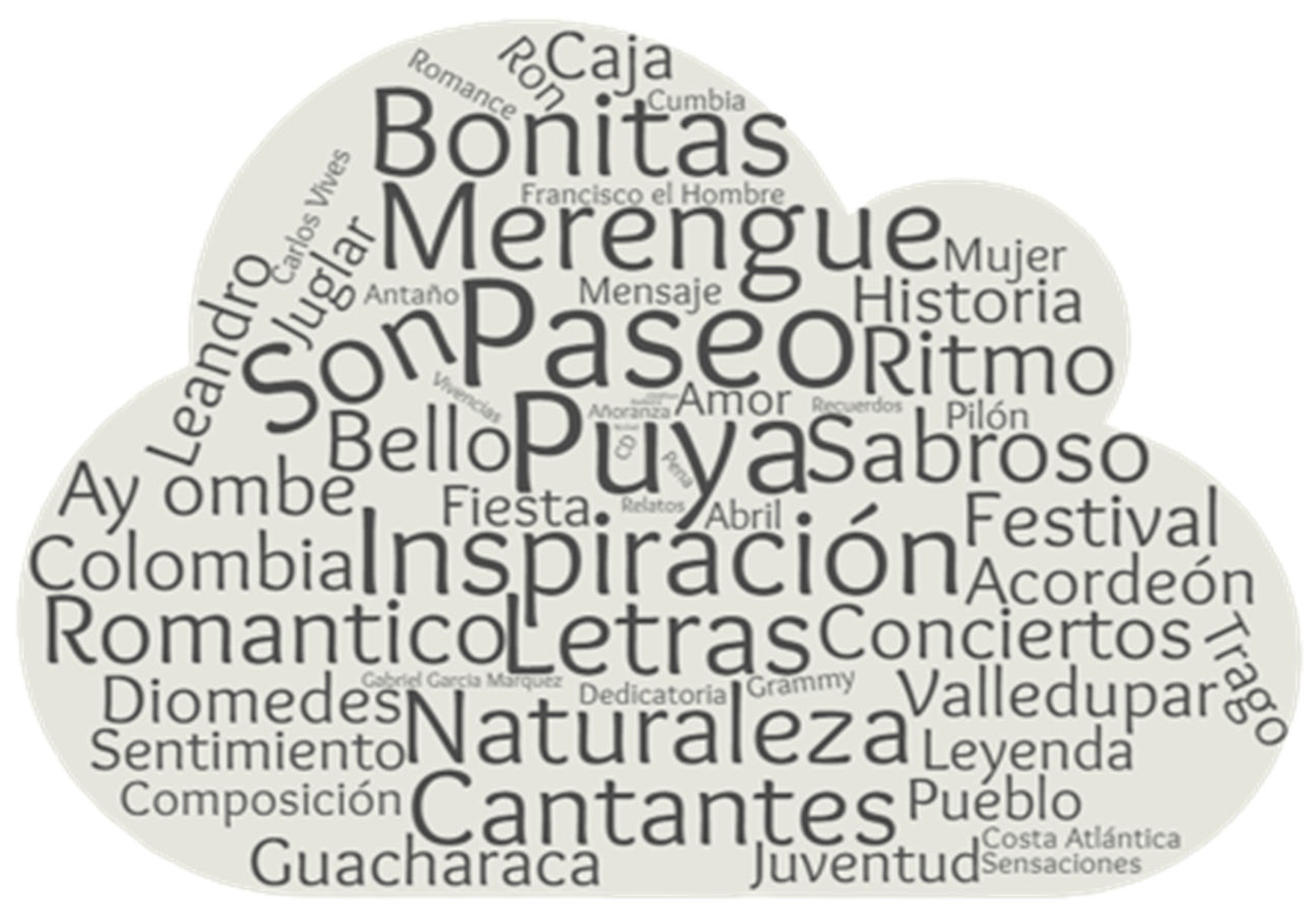
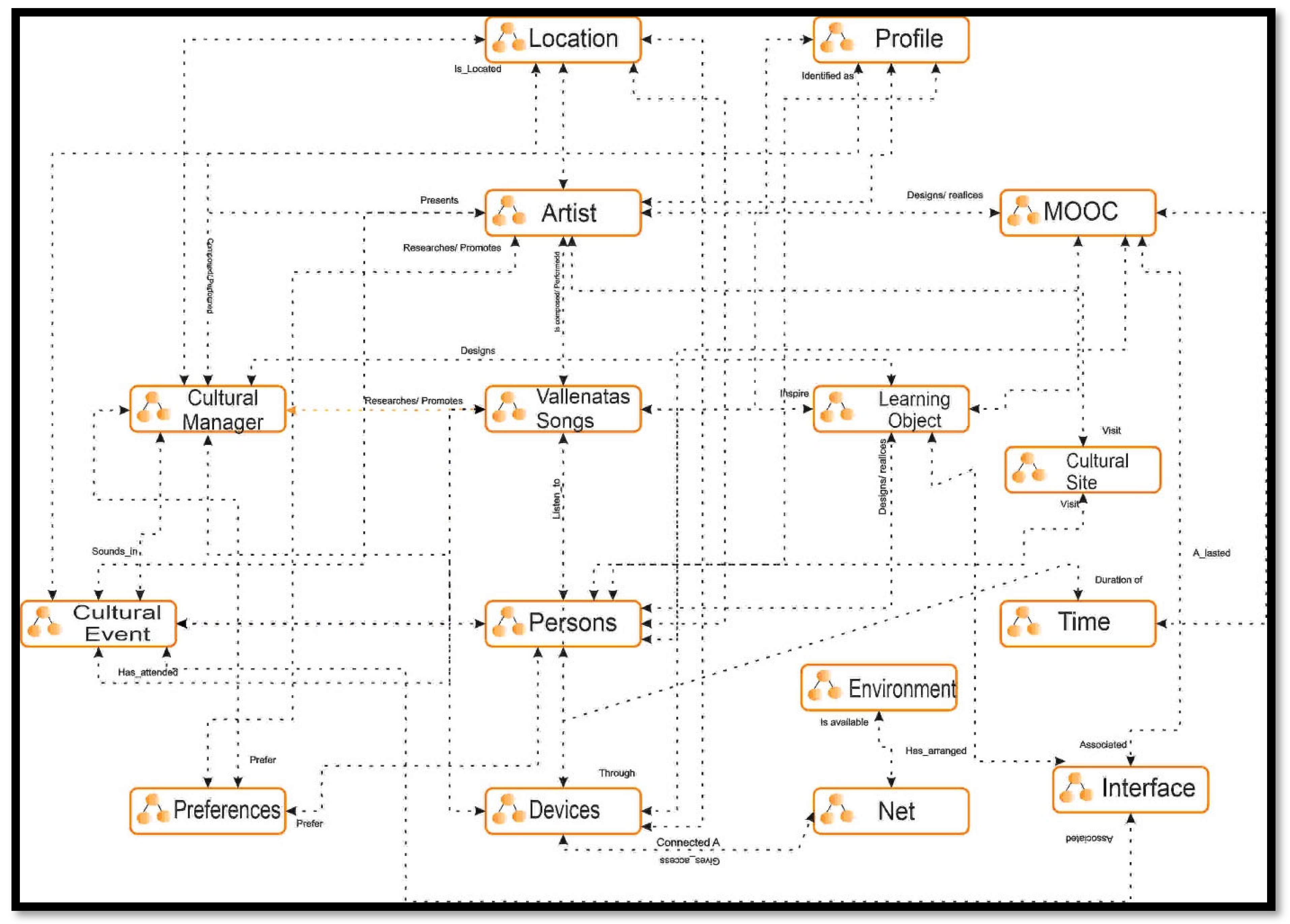
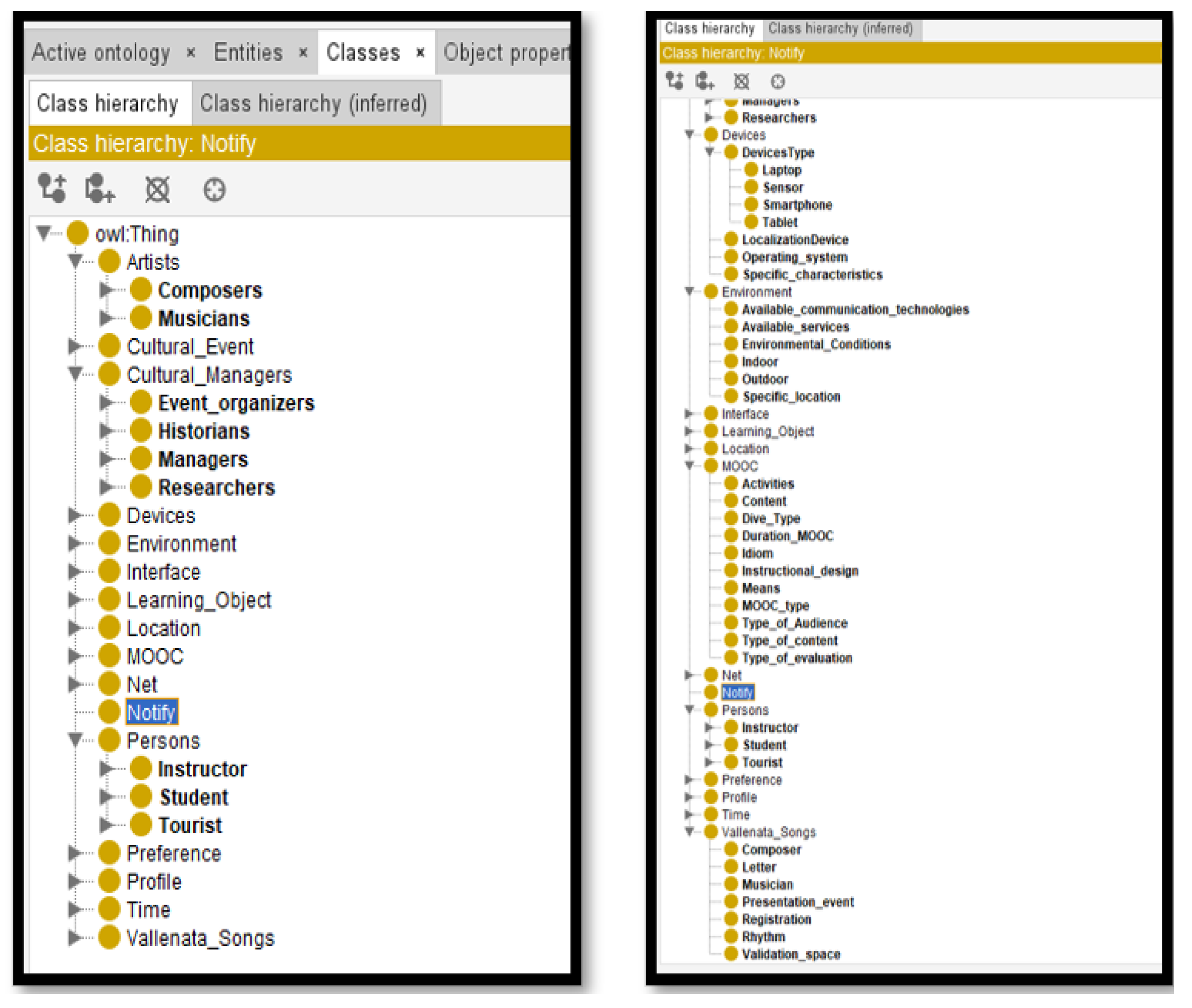
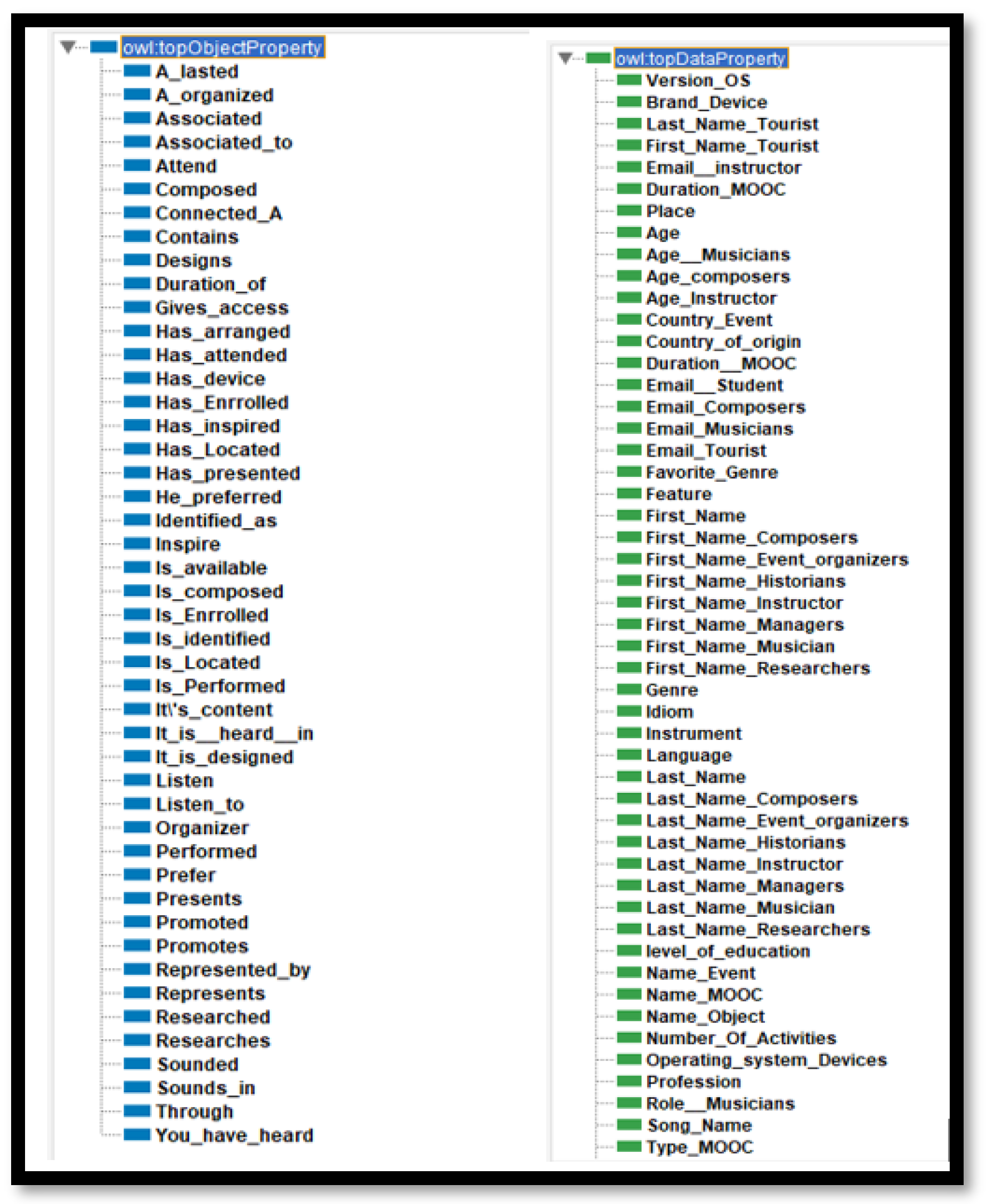
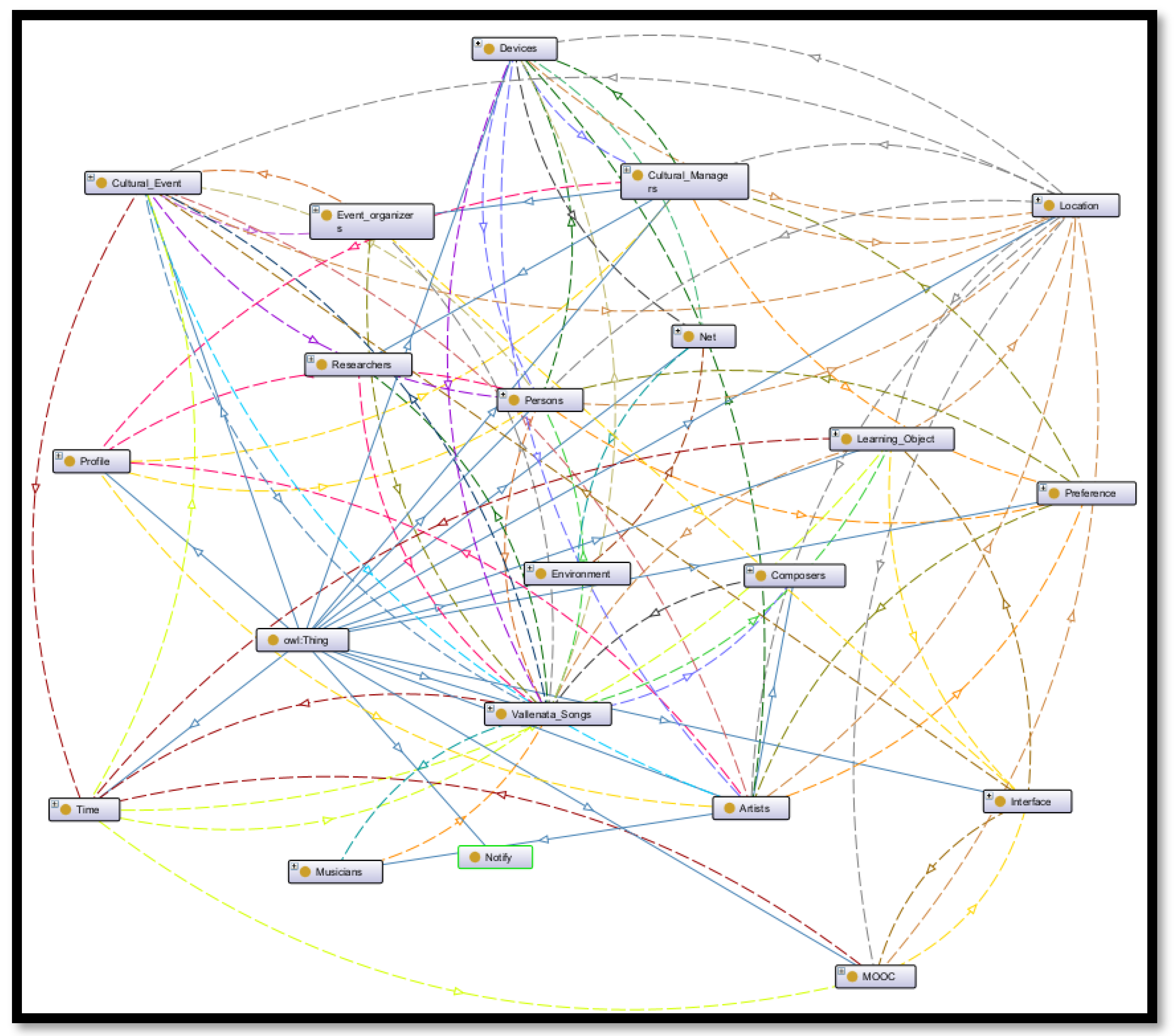

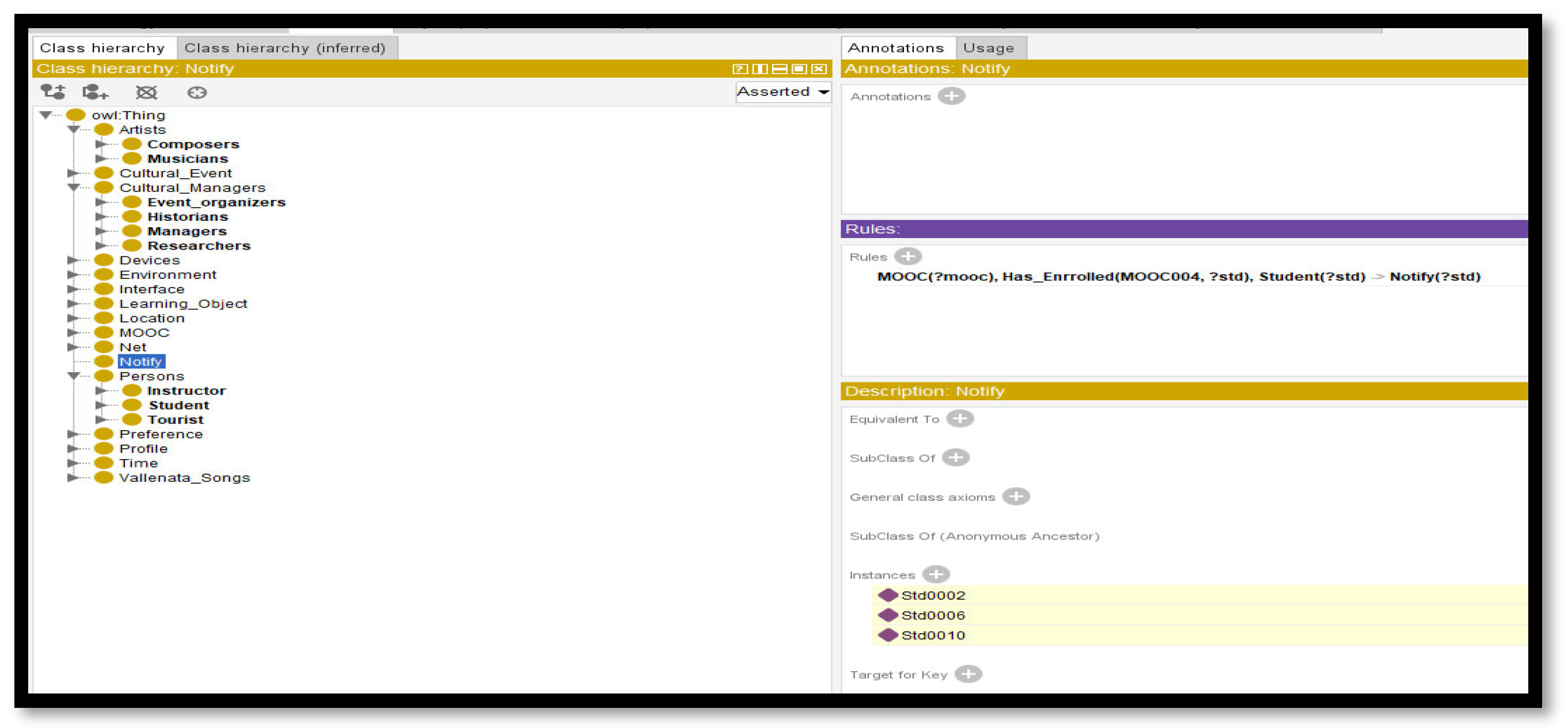

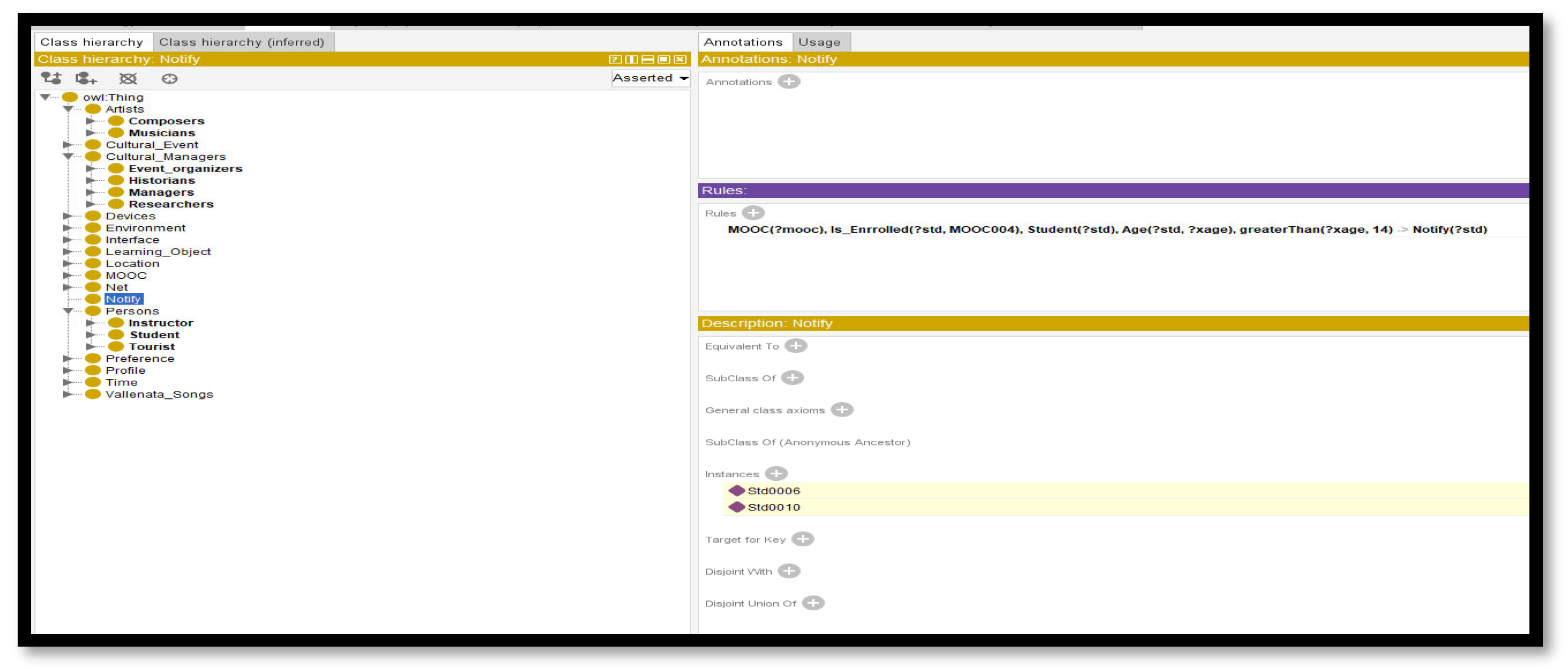
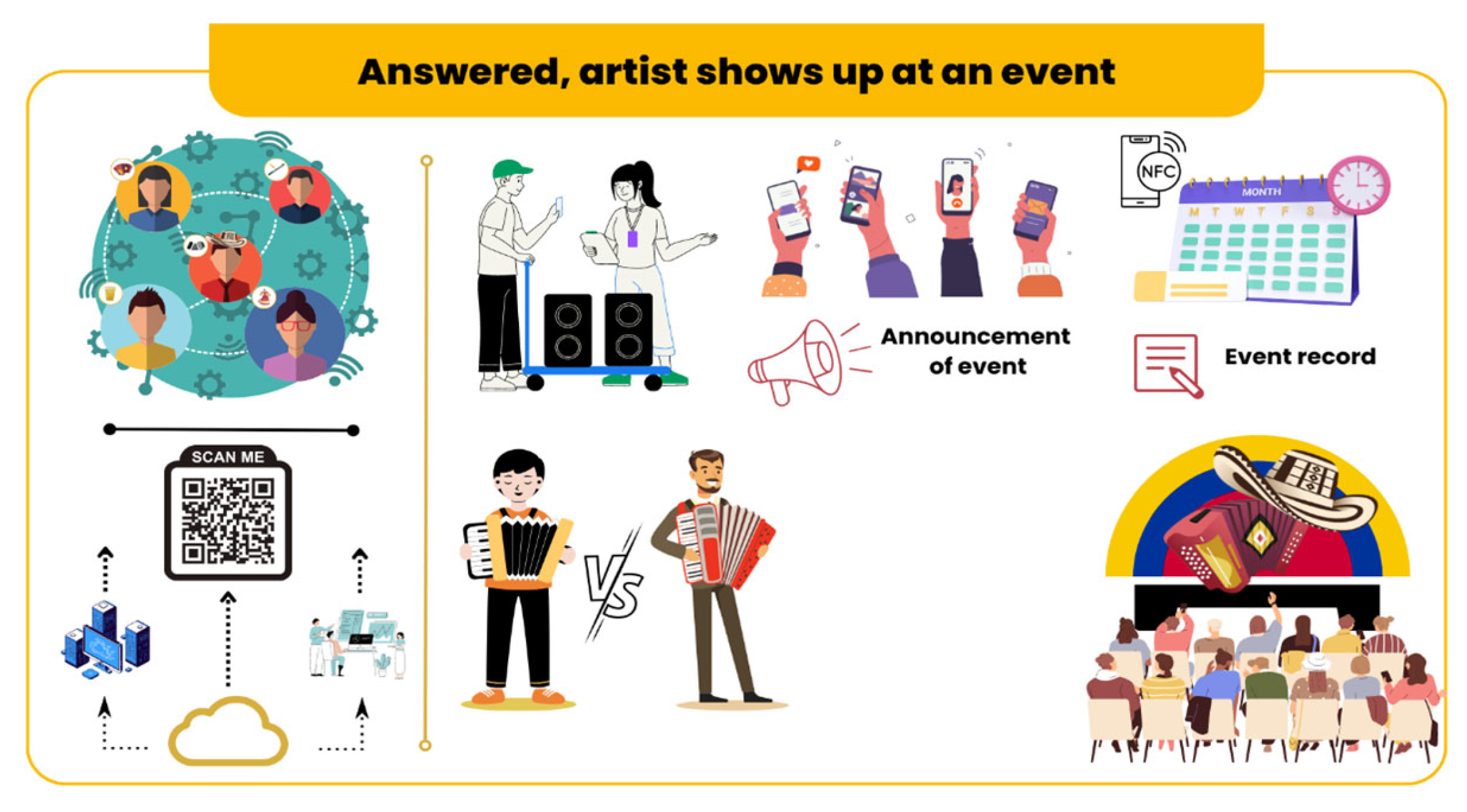

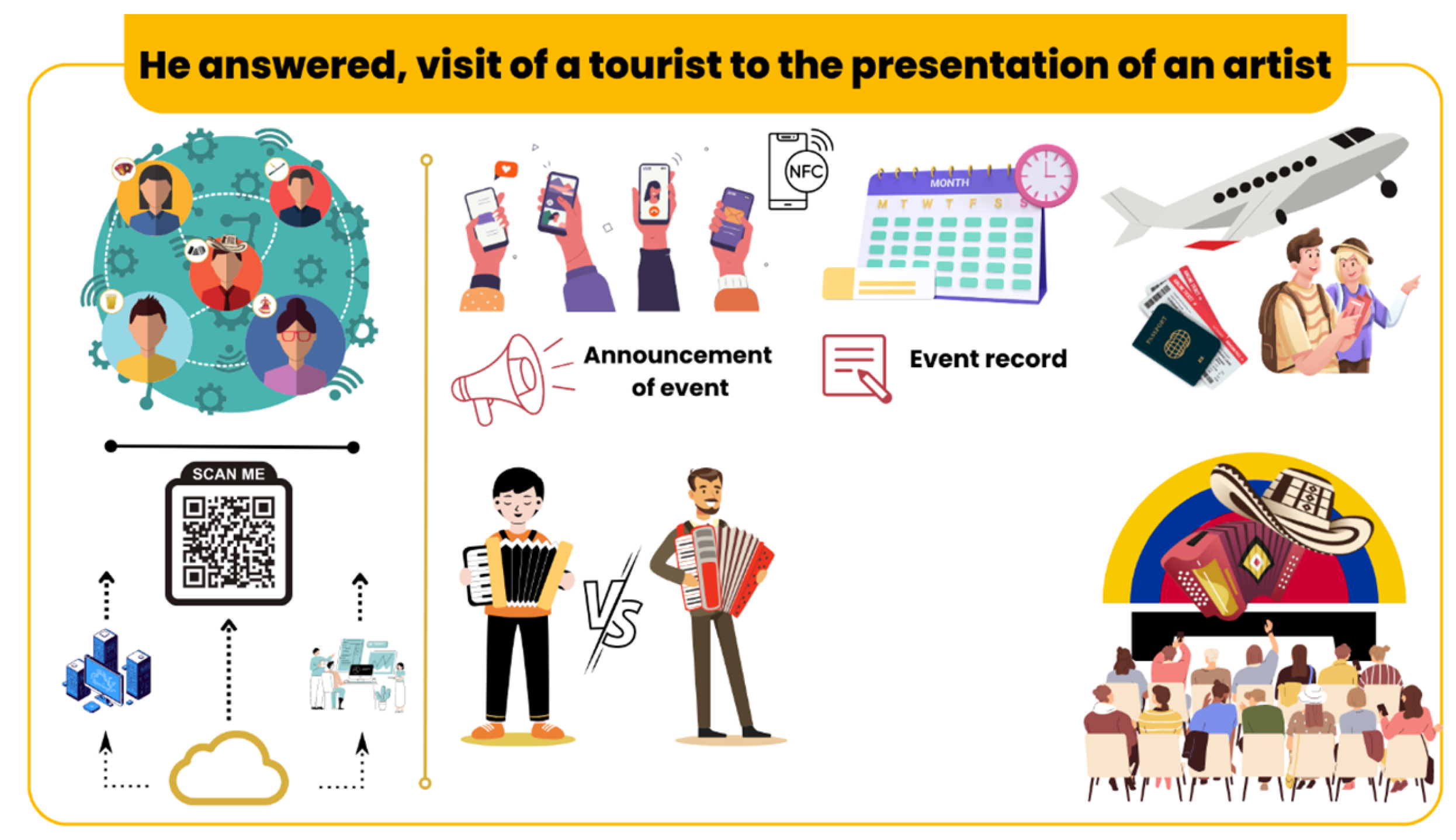
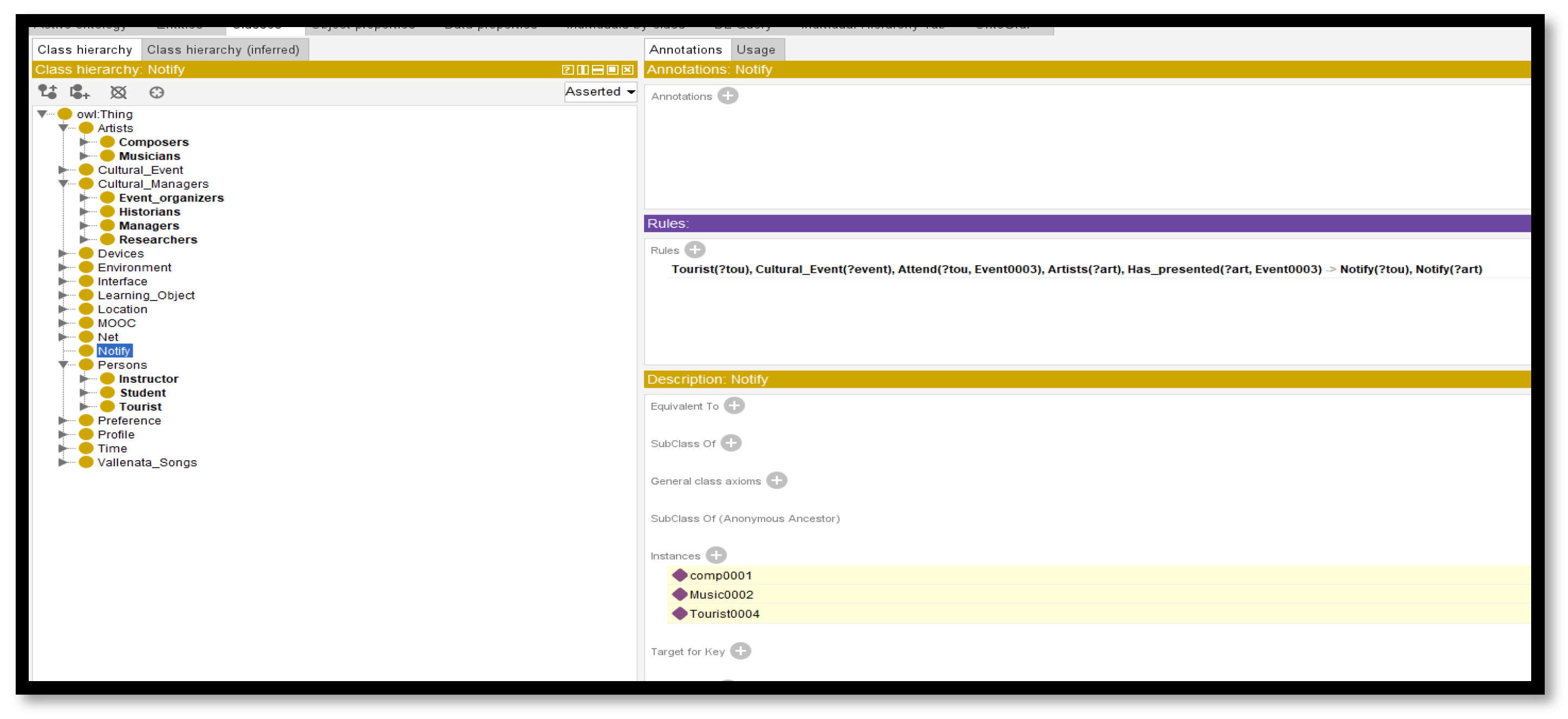
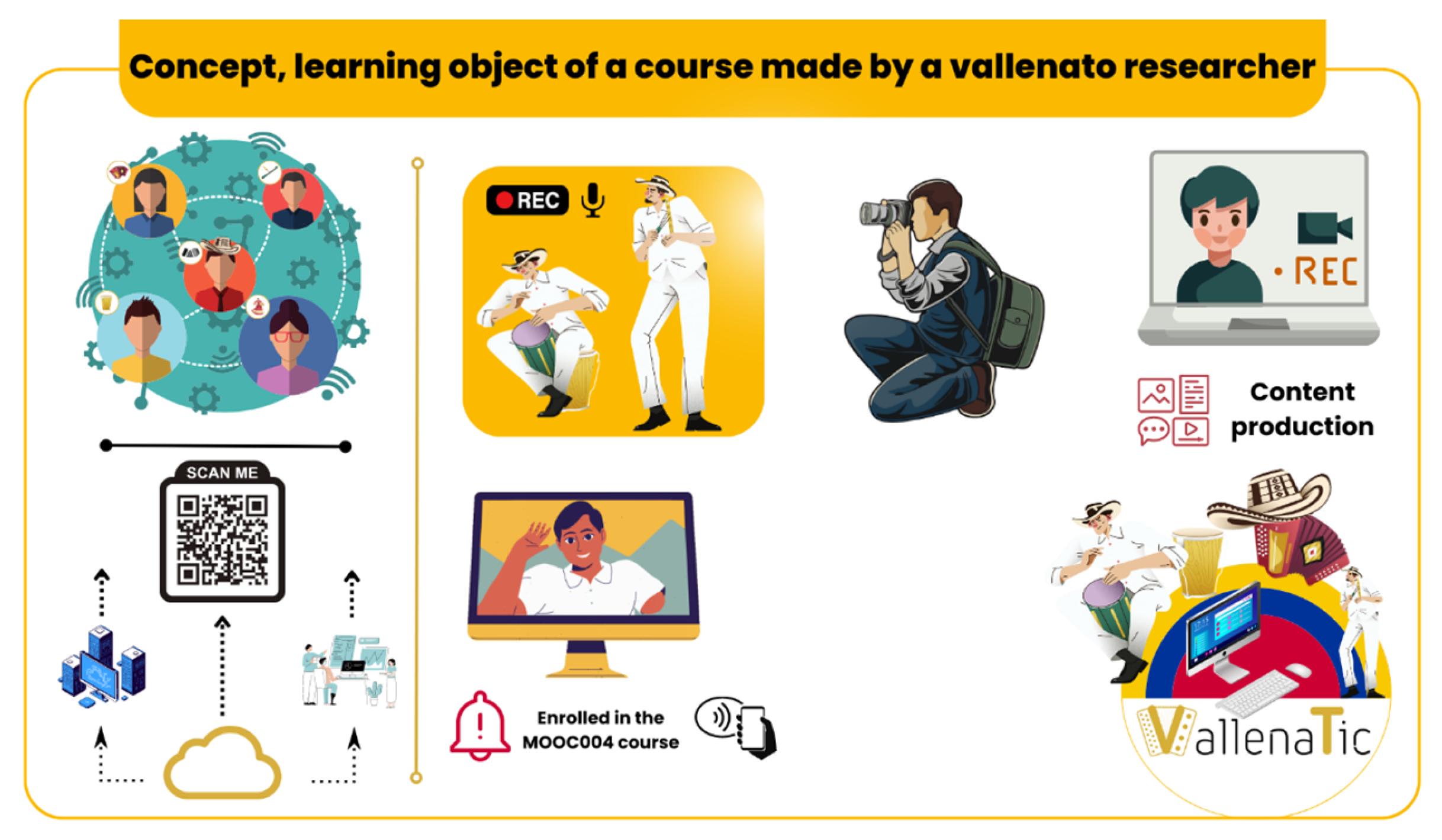
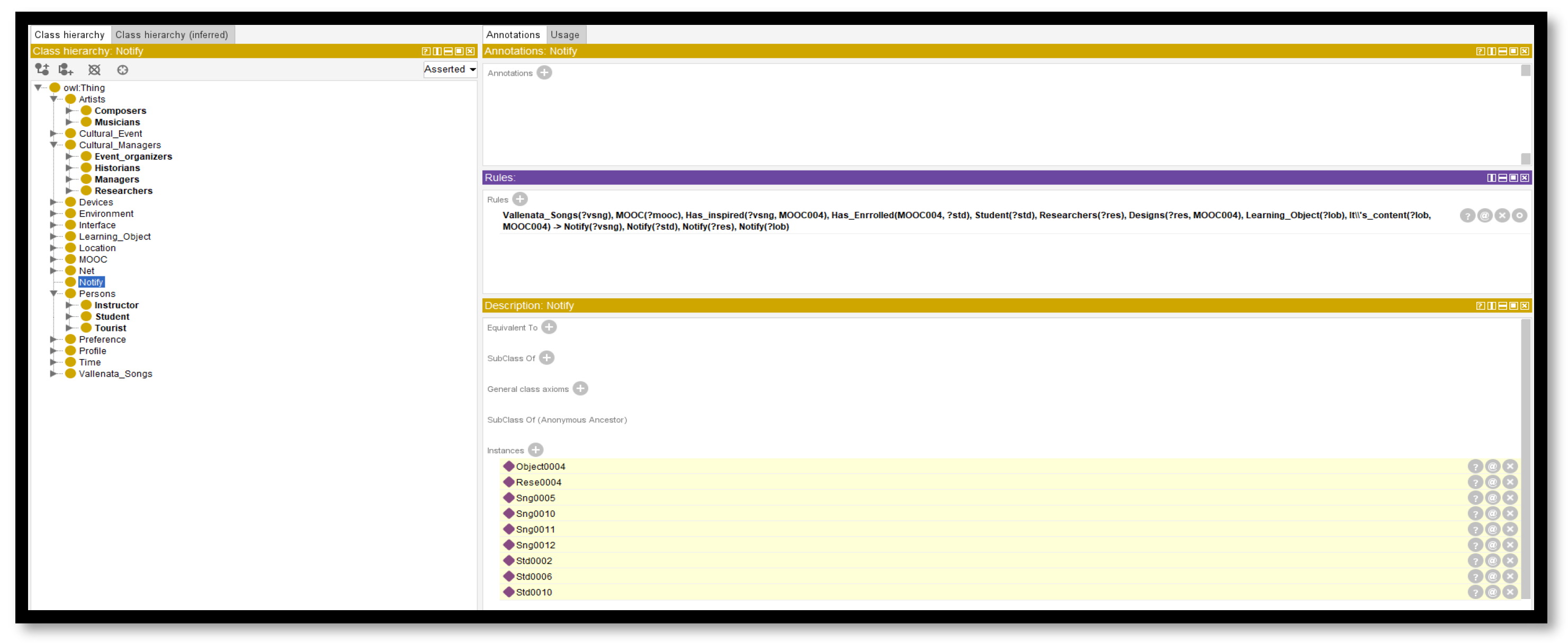
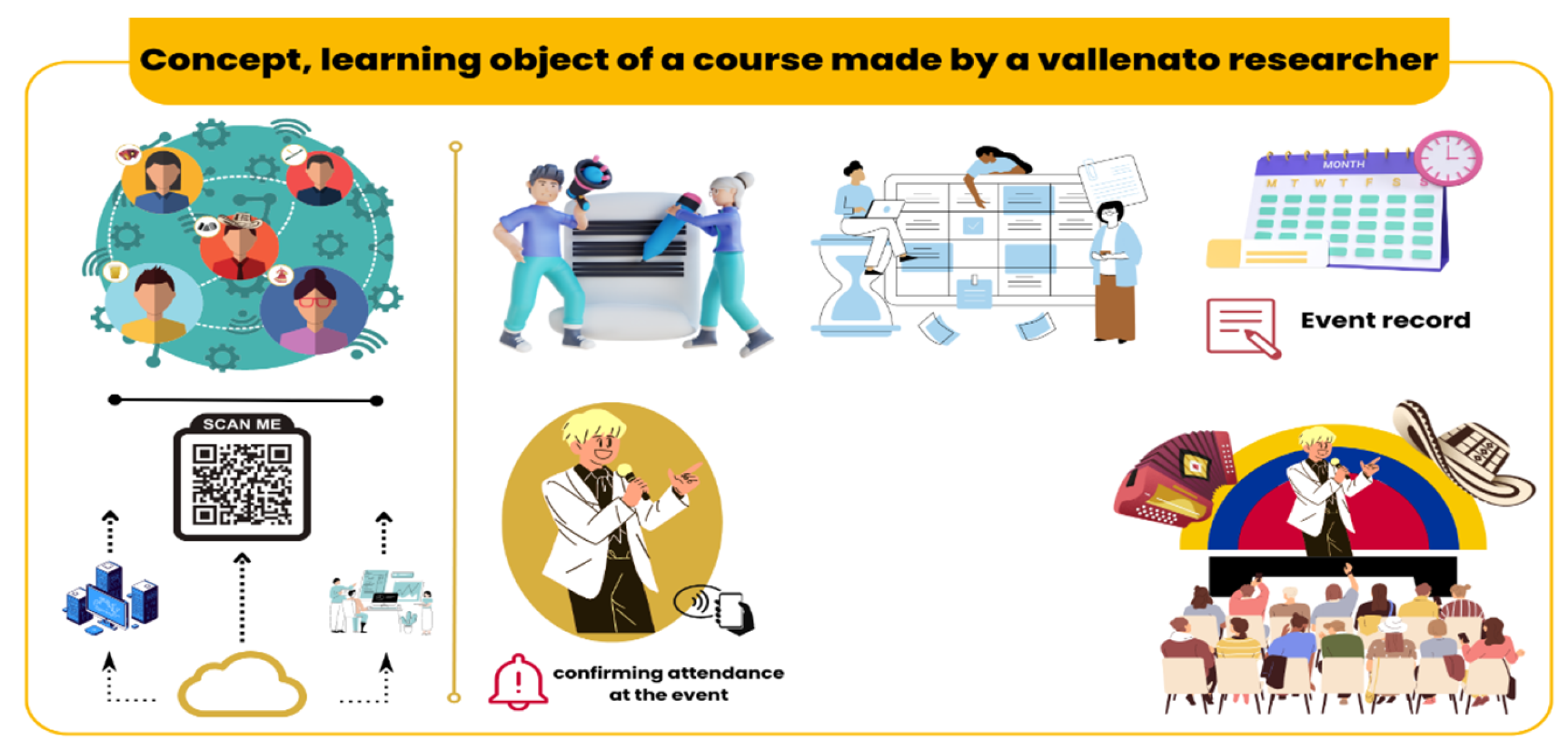
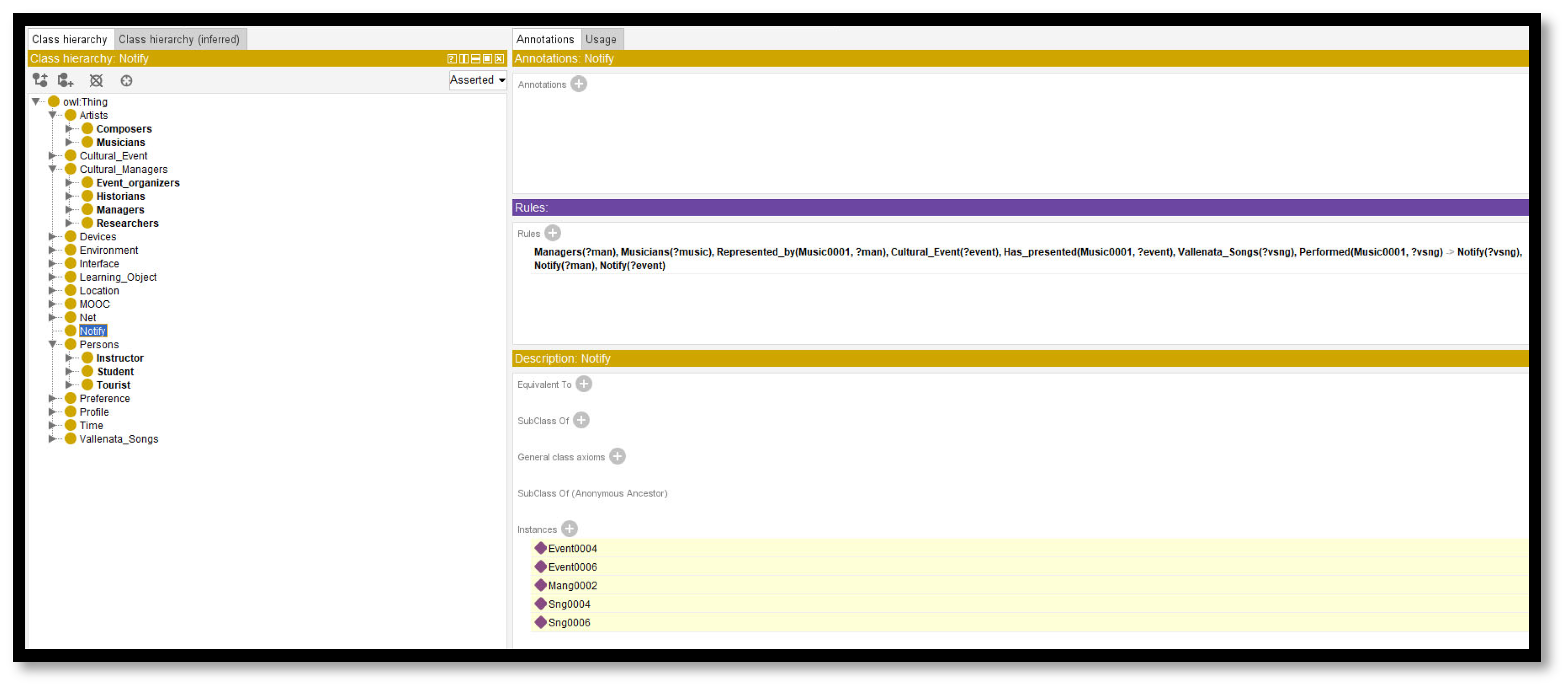
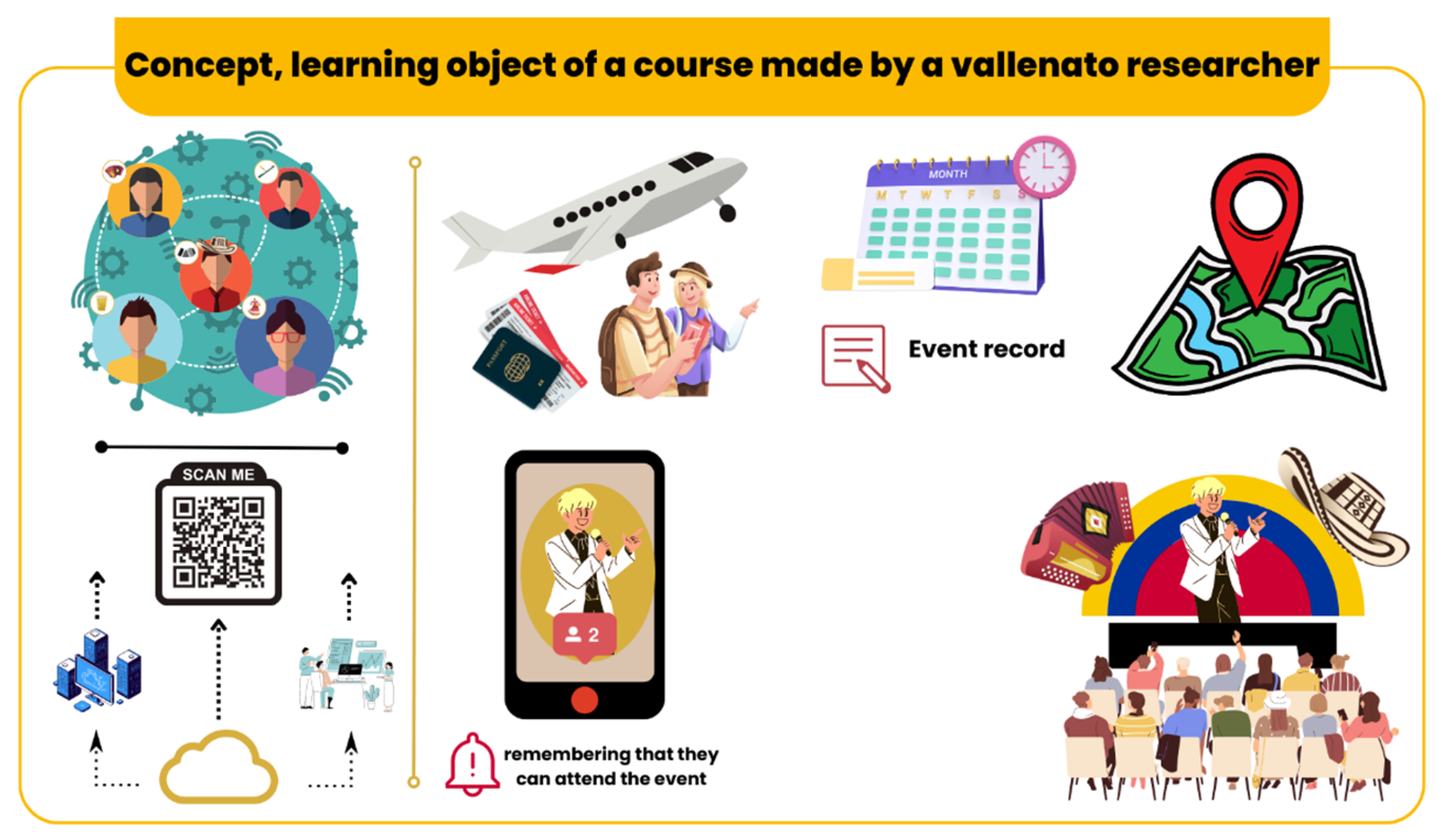
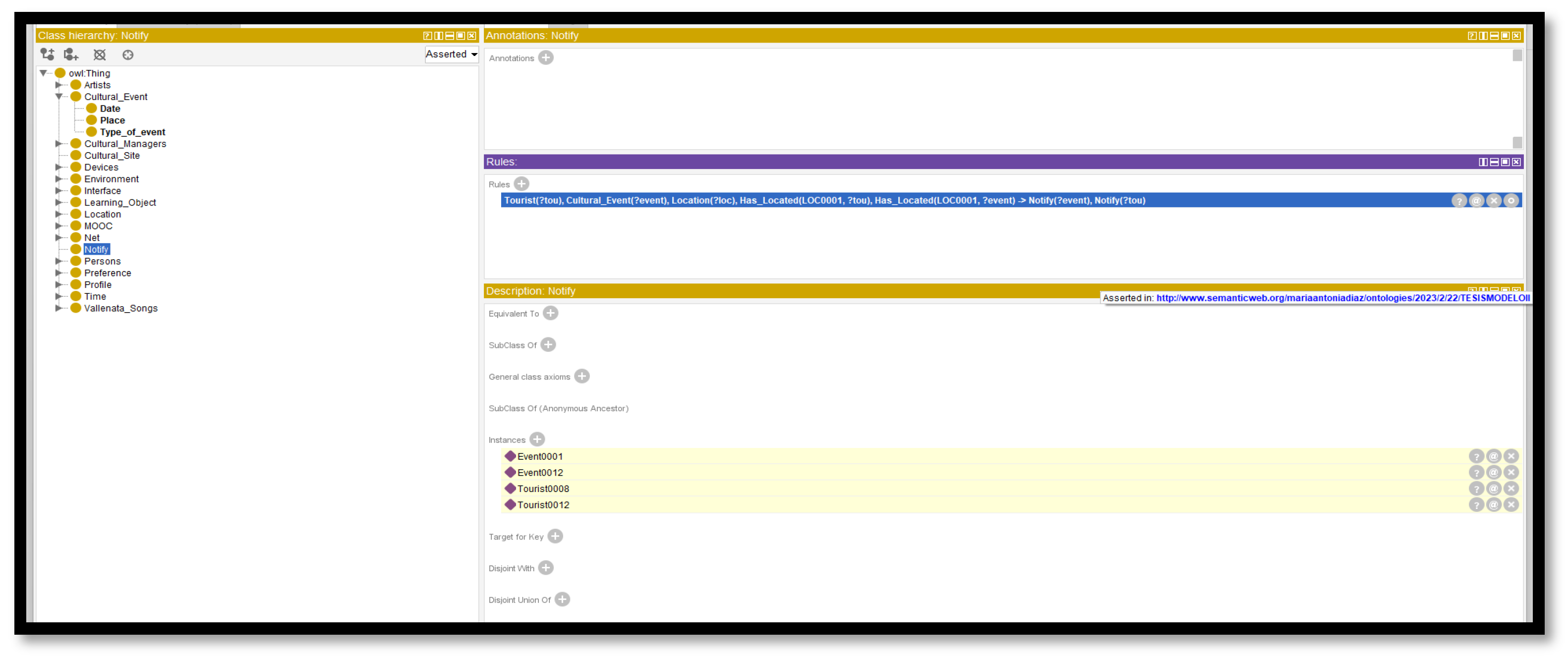
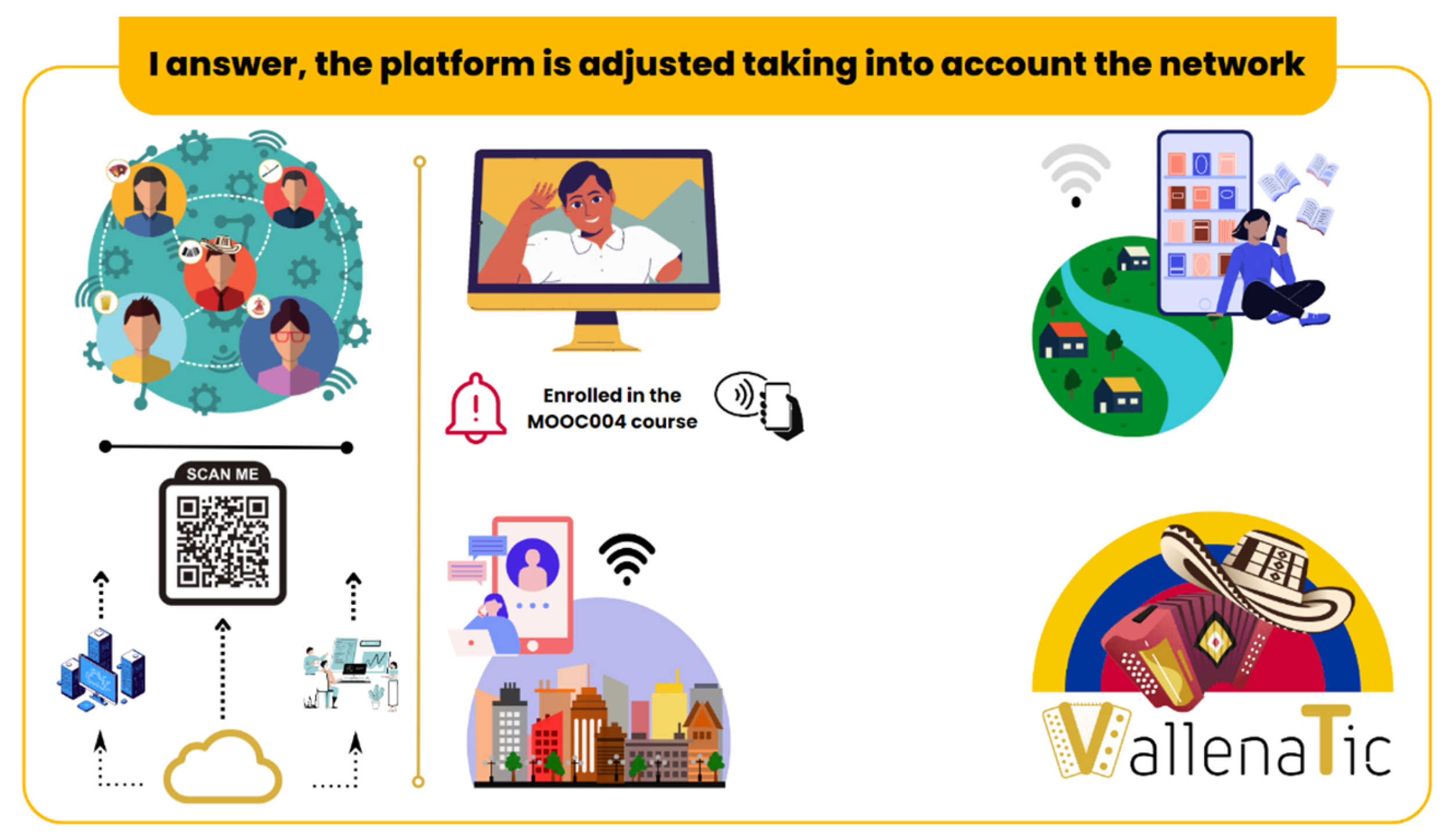
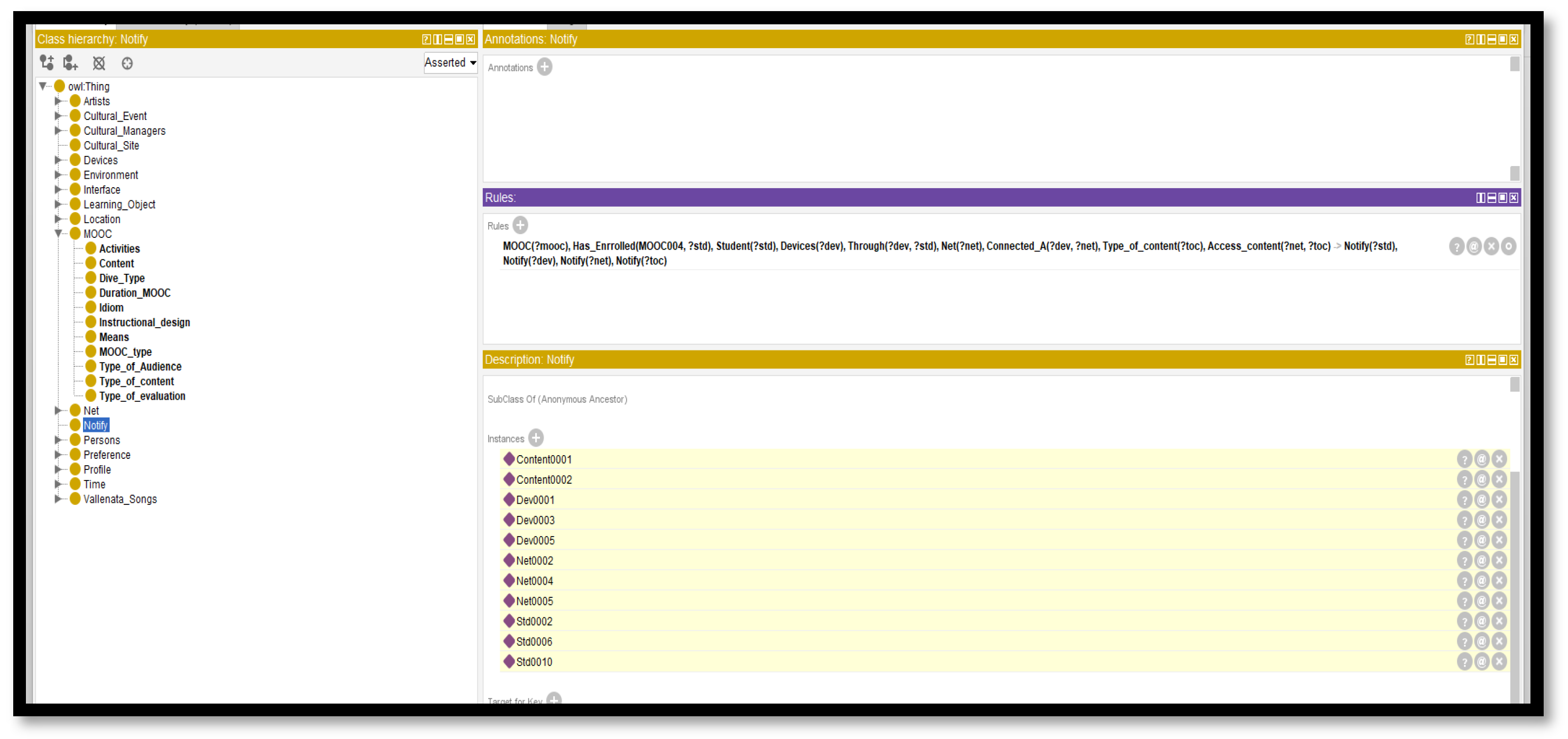
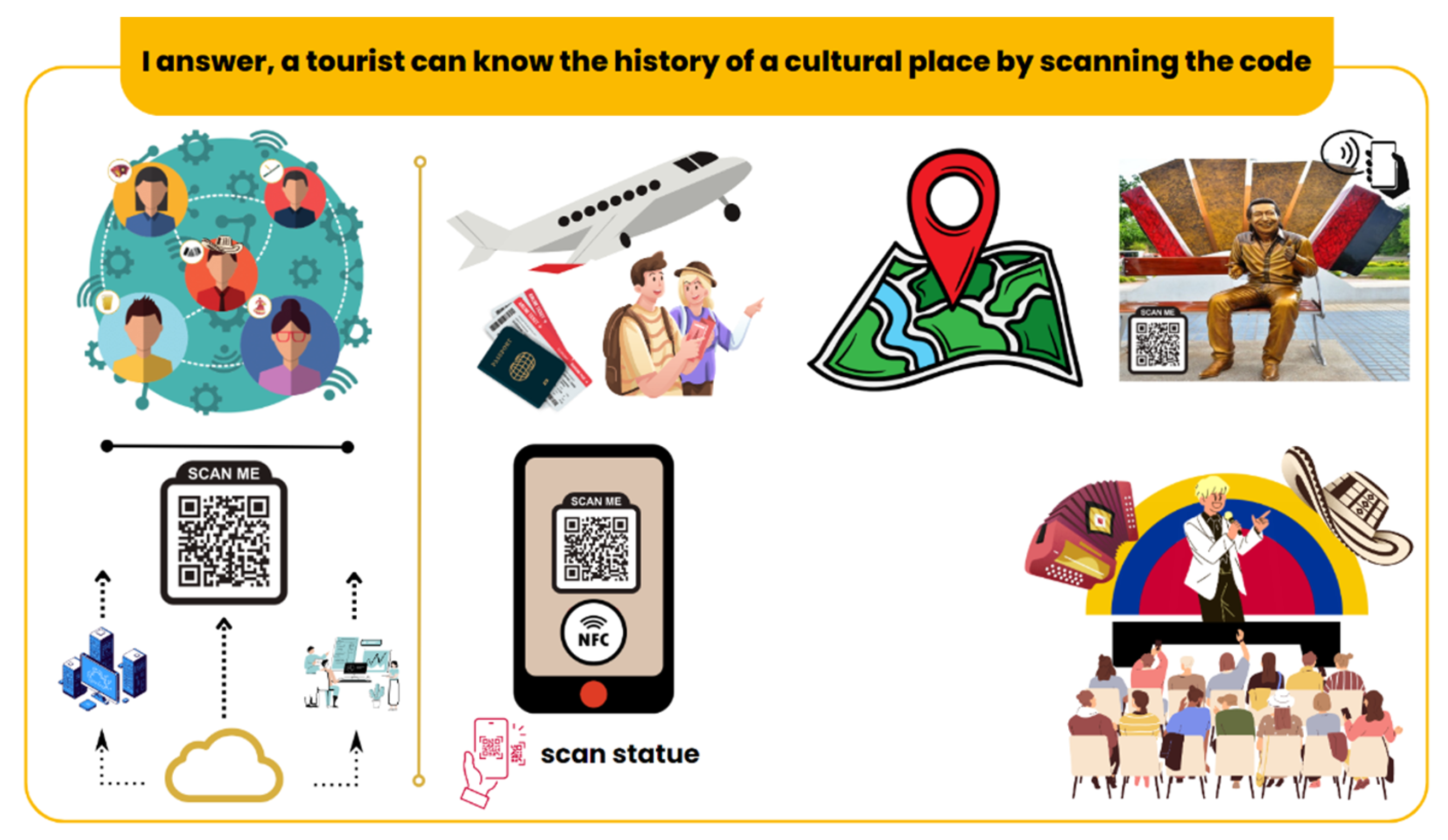

| Uschold y King (1995) [18] | Grüninger and Fox (1995)—TOVE Methodology [19] | Kactus (1997) [20,21] | Fernández-López, Gómez-Pérez and Juristo (1997)—Methontology [22,23] | On-To-Knowledge (2001) [24] | Ontology Development 101 | Noy y McGuinness (2001)—Simple Knowledge-Engineering Methodology | NeOn Methodology (2010) | Stuart (2016) |
|---|---|---|---|---|---|---|---|---|
| 1. Identify the purpose | 1. Determine the competence of the ontology | 1. Application Specification | 1. Specification | 1. Feasibility study | 1. Determine the domain and scope of the ontology | 1. Determine the domain and scope of the ontology | Scenario 1: Ontology networks from the application specification. | 1. Scope of the ontology |
| 2. Construct the ontology a. Capture the ontology b. Encode the ontology c. Integrate with existing ontologies | 2. Define ontology terminology | 2. Preliminary design based on relevant toplevel ontological categories | 2. Knowledge acquisition | 2. Launch. (Delimitation of domains, statement of objectives, extraction of information sources, description of users and future applications). | 2. Determine the intent to use the ontology | 2. Consider reusing existing ontologies | Scenario 2: The reuse and reengineering of non-ontological resources (NOR). | 2. Reuse of the ontology |
| 3. Evaluate | 3. Specify terminology definitions and restrictions | 3. Refinement and structuring of ontology. | 3. Conceptualization | 3. Improvement | 3. Reuse existing controlled ontologies or vocabularies. | 3. List important terms in the ontology | Scenario 3: Development of ontology networks through reuse of ontological resources. | 3. Identifying the appropriate software |
| 4. Document | 4. Test the competence of ontology to demonstrate the integrity of theories | 4. Integration | 3. Evaluation | 4. List the important domain terms. | 4. Define classes and hierarchies | Scenario 4. Development of ontology networks through reuse and reengineering of ontological resources. | 4. Knowledge acquisition | |
| 5. Implementation | 4. Maintenance | 5. Define class hierarchy. | 5. Define class properties | Scenario 5. Development of ontology networks through reuse and mixing of ontological resources. | 5. Identification of important terms | |||
| 6. Evaluation | 6. Create the instances. | 6. Define the facets | Scenario 6. Development of ontology networks through reuse, mixing and reengineering of ontological resources. | 6. Identification of additional terms, attributes, and relationships | ||||
| 7. Documentation | 7. Create instances | Scenario 7. Development of ontology networks through reuse of ontological design patterns (ODPs). | 7. Specification of definitions | |||||
| Scenario 8. Development of ontology networks through restructuring of ontological resources. | 8. Integration with existing ontologies | |||||||
| Scenario 9. Development of ontology networks through the localization of ontological resources. | 9. Implementation | |||||||
| 10. Evaluation | ||||||||
| 11. Documentation | ||||||||
| 12. Sustainability |
| Task | What They Do | How They Do It | Who Does It |
|---|---|---|---|
| 1 | Identification of the purpose, scope, and implementation language of the ontology | A series of interviews with users and domain experts should be conducted. | Ontology Development Team |
| 2 | Identification of the intended end users. | A series of interviews with users and domain experts should be conducted. | Ontology Development Team |
| 3 | Identification of intended uses | A series of interviews with users and domain experts should be conducted. | Ontology Development Team |
| 4 | Identification of requirements. | A series of interviews with users and domain experts should be conducted. | Ontology Development Team, Experts. |
| The requirements are divided into two types: | |||
| Non-functional requirements that refer to general aspects not related to the knowledge to be represented by the ontology. | |||
| Functional requirements that are content requirements related to the knowledge that the ontology should represent. These requirements should be written in the form of competency questions with their respective answers. | |||
| 5 | Grouping of the functional requirements. | Exhaustive analysis of what was obtained in the previous task. | Ontology Development Team |
| General users | Students |
| Tourists | |
| People interested in learning about Vallenato | |
| Arts teachers | |
| Physical Education Teachers | |
| Visitors to the Vallenato Music Cultural Center | |
| Academic | |
| Artists related to vallenato music | Singers |
| Singer | |
| Composers | |
| Accordionists | |
| Guacharaqueros | |
| Cashiers | |
| Chorus | |
| Arrangers | |
| Congas | |
| Drummer | |
| Pianist | |
| Sound Engineer | |
| Short | |
| Euphonium | |
| Clarinet | |
| Trombone | |
| Guitarist | |
| Representatives | |
| Cultural managers related to Vallenato | Representatives of Vallenato Music Schools |
| Representatives of Foundations related to Vallenato | |
| Vallenato Historians | |
| Members of Vallenato festival boards | |
| Teachers | |
| Cultural managers | |
| Rectors of Educational Institutions | |
| Government Institutions |
| Relationship | Concep | Range | Inverse |
|---|---|---|---|
| Connects_to | Devices | Net | Give_Acces |
| Contains | MOOC | Learning_Object | It’s_content |
| Duration_of | Time | MOOC | It_Last |
| Learning_Object | |||
| Cultural_Event | |||
| Has_inspired | Vallenato_Songs | Learning_Object | Get_inspired |
| Identifies_as | Profile/Role | Users | It_is_identified_as |
| Cultural_Managers | |||
| Instructors | |||
| Musicians | |||
| Tourists | |||
| Is_available | Environment | Net | Has_arranged |
| Is_designed | MOOC | Cultural_Managers | Has_designed |
| Instructors | |||
| Is_heard_in | Devices | Vallenato_Songs | It_is_heard_by |
| Is_located | Location | Devices | Has_located |
| Users | |||
| Environment | |||
| Cultural_Managers | |||
| Instructors | |||
| MOOC | |||
| Learning_Object | |||
| Net | |||
| Cultural_Event | |||
| Is_presented_by | Cultural_Event | Composers | Has_presented |
| Musicians | |||
| Is_promoted_by | Cultural_Managers | Vallenato_Songs | Has_promoted |
| Is sung/Played by | Musicians | Vallenato_Songs | Has_sung/Played |
| Is written by | Composers | Vallenato_Songs | You_have_written |
| Is_Enrrolled | User | MOOC | Has_Enrrolled |
| It_is_through | Devices | Learning_Object | Is_through |
| Cultural_Event | |||
| Listen_to_me | Tourists | Vallenato_Songs | You’ve_heard |
| Organized_by | Cultural_Managers | Cultural_Event | Has_organized |
| Partners | Interface | MOOC | Associated_to |
| Learning_Object | |||
| Cultural_Event | |||
| Prefer | Preference | Users | Has_preferred |
| Cultural_Managers | |||
| Instructors | |||
| Musicians | |||
| Tourists | |||
| Presented | Vallenato_Songs | Cultural_Event | It_is_sung_in |
| Went | Tourists | Cultural_Event | Attend |
| You_have_accessed | Devices | Users | Access |
| Cultural_Managers | |||
| Instructors | |||
| Musicians | |||
| Tourists |
| Ontological Model | Purpose | Artist | Devices | Persons | Environment | Cultural Managers | Interface | Location | MOOC | Learning Object | Profile | Preference | Net | Time | Cultural Event | Vallenatas Songs | Cultural Site |
|---|---|---|---|---|---|---|---|---|---|---|---|---|---|---|---|---|---|
| ONTOLOGIES FOR CULTURAL HERITAGE MANAGEMENT | |||||||||||||||||
| ArCo (Arquitecture of Knowledge) [11] | Create a network of ontologies to represent cultural heritage data and publish the General Catalog proposed by the Italian Ministry of Culture. | X | X | P | ✓ | P | ✓ | ✓ | X | X | X | X | X | X | ✓ | X | ✓ |
| MOM [13] | It is an ontology for the management of cultural heritage, takes classes of the following Ontologies: CIDOC CRM, EDM, ORE, (https://www.openarchives.org/ore/1.0/datamodel) FOAF (http://www.foaf-project.org/), DC (https://www.dublincore.org/specifications/dublin-core/dces/) y SKOS (https://www.w3.org/2004/02/skos/, accessed on 3 February 2023). | X | X | ✓ | X | P/ | X | ✓ | X | ✓/ | X | X | X | ✓/ | ✓ | X | ✓ |
| CURIOCITY (Cultural Heritage for Urban Tourism in Indoor/Outdoor environments of the CITY) [12] | Designed to represent cultural heritage knowledge based on UNESCO definitions. | ✓ | P/ | ✓ | P/ | X | X | ✓ | X | X | ✓/ | X | X | ✓/ | P/ | P/ | ✓ |
| CIDOC CRM [7]. | It is the largest and most complex ontology in terms of cultural heritage, has 99 classes and 188 properties. | P/ | X | ✓ | ✓/ | X | P/ | P/ | X | X | P/ | P/ | X | P/ | ✓/ | X | ✓ |
| ONTOLOGIES FORLEARNING ENVIRONMENTS | |||||||||||||||||
| An Ontology-based Framework or Context-aware Adaptive E-learning System [15] | Categorization of contextual information and modeling, along with the use of ontology to explicitly specify the context of the learner in an e-learning environment. | X | ✓ | ✓/ | X | X | X | ✓/ | X | X | X | P/ | X | ✓/ | X | X | X |
| A simple model of smart learning environment [16] | An ontology model for intelligent learning environments supported by contextual awareness. | X | ✓ | ✓/ | X | X | X | ✓ | X | ✓ | ✓/ | ✓/ | X | ✓ | X | X | X |
| A model for learning objects adaptation in light of mobile and context-aware computing [17] | Architectural model for the adaptation of objects from Learning considering device characteristics, learning style, and contextual information from Other Students | X | ✓ | ✓/ | X | X | ✓ | ✓ | X | ✓ | ✓ | X | X | X | X | X | X |
| Vallenatic Proposed model | An ontological model for the representation of vallenato as cultural heritage in a context-aware | ✓ | ✓ | ✓ | ✓ | ✓ | ✓ | ✓ | ✓ | ✓ | ✓ | ✓ | ✓ | ✓ | ✓ | ✓ | ✓ |
Disclaimer/Publisher’s Note: The statements, opinions and data contained in all publications are solely those of the individual author(s) and contributor(s) and not of MDPI and/or the editor(s). MDPI and/or the editor(s) disclaim responsibility for any injury to people or property resulting from any ideas, methods, instructions or products referred to in the content. |
© 2023 by the authors. Licensee MDPI, Basel, Switzerland. This article is an open access article distributed under the terms and conditions of the Creative Commons Attribution (CC BY) license (https://creativecommons.org/licenses/by/4.0/).
Share and Cite
Diaz-Mendoza, M.A.; De-La-Hoz-Franco, E.; Gómez Gómez, J.E.; Ramírez-Velarde, R. An Ontological Model for the Representation of Vallenato as Cultural Heritage in a Context-Aware System. Heritage 2023, 6, 5648-5671. https://doi.org/10.3390/heritage6080297
Diaz-Mendoza MA, De-La-Hoz-Franco E, Gómez Gómez JE, Ramírez-Velarde R. An Ontological Model for the Representation of Vallenato as Cultural Heritage in a Context-Aware System. Heritage. 2023; 6(8):5648-5671. https://doi.org/10.3390/heritage6080297
Chicago/Turabian StyleDiaz-Mendoza, María Antonia, Emiro De-La-Hoz-Franco, Jorge Eliecer Gómez Gómez, and Raúl Ramírez-Velarde. 2023. "An Ontological Model for the Representation of Vallenato as Cultural Heritage in a Context-Aware System" Heritage 6, no. 8: 5648-5671. https://doi.org/10.3390/heritage6080297
APA StyleDiaz-Mendoza, M. A., De-La-Hoz-Franco, E., Gómez Gómez, J. E., & Ramírez-Velarde, R. (2023). An Ontological Model for the Representation of Vallenato as Cultural Heritage in a Context-Aware System. Heritage, 6(8), 5648-5671. https://doi.org/10.3390/heritage6080297







